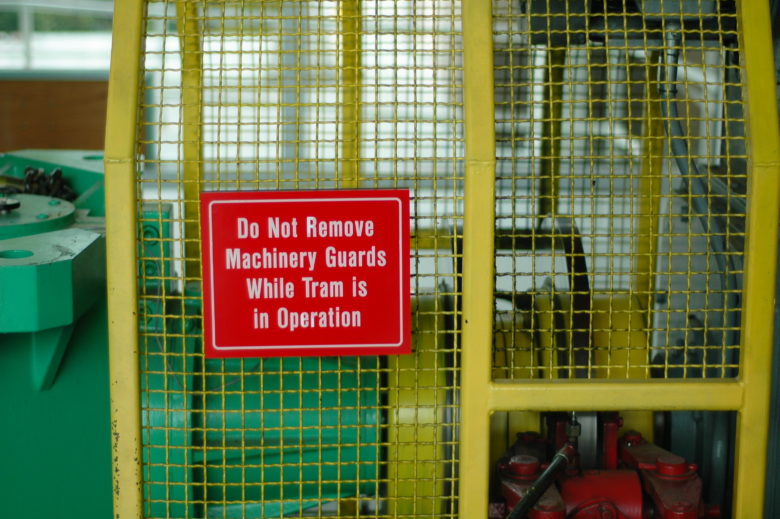According to OSHA, machine operators suffer approximately 18,000 amputations, lacerations, crushing injuries, abrasions, and over 800 deaths per year. Sometimes the topics that seem like common knowledge aren’t talked about enough. Choosing a specific “problem” topic for your toolbox talks can go a long way in maintaining safety among workers. In the case of machine guarding, there are a lot of issues you can cover in toolbox talks.
OSHA’s machine guarding standard states: “One or more methods of machine guarding shall be provided to protect the operator and other employees in the machine area from hazards such as those created by point of operation, ingoing nip points, rotating parts, flying chips, and sparks.” For your toolbox talk, why not start with the basics? According to OSHA, the four general types of guards are fixed, interlocked, adjustable and self-adjusting—begin by discussing the common hazards associated with them.
Fixed guards
A fixed guard is a permanent part of a machine that protects by a physical barrier to the hazard. It is not dependent on moving parts to function. Examples of this type of guard include a barrier, cover or safety fence. Fixed guards make it more difficult to physically access the machine, making it the preferred type of guard. These types of guards could limit visibility, which could prompt workers to want to remove them. When it comes to maintenance or repair of the machine, the guard often has to be removed. Your toolbox talk should define the importance of a pre-use inspection to ensure the guard is in place—because it’s not always the employee who removes the guard.
Interlocked guards
An interlocked guard may use electrical, hydraulic, mechanical or pneumatic power, and once opened (or removed) all power is automatically shut off and the moving parts of the machine are stopped. The machine can’t be restarted until the guard is back in place. Examples of interlocked guards include gates, fences, and protective covers for presses, blades and moving parts. These guards may be easy to disengage, which is great for removing jams as it’s not as time-consuming as removing a fixed guard would be. But these types of guards will require more careful adjustment and maintenance—an important note when it comes to the reasons that people work without guards.
Adjustable guards
An adjustable guard, like a fixed guard, is a permanent part of the machine and may be dependent on moving parts to function. The barrier allows flexibility and may be adjusted to suit many different operations (including varying sizes or specific applications). It may interfere with visibility so the desire to want to remove it could be increased. One major concern with an adjustable guard is that the operator’s hand can enter the dangerous area with moving parts and may not be protected when the guard is not locked or adjusted properly. It also may require frequent maintenance which could cause workers to want to continue their work without it.
Self-adjusting guards
A self-adjusting guard creates a barrier between the operator and the danger zone, only allowing enough room for the material passing through to enter the danger zone, returning to the rest position once the material is through. Like most guards, it may impede visibility and require frequent maintenance and adjustment which increases the desire to remove them. And even though they sound safer than the other guards, these guards are still capable of failing to provide protection.
Lockout/tagout
The machine guards are there for protection while the machine is in operation. Lockout/tagout (LOTO) procedures, meanwhile, are the actions you take when the machine needs to be serviced or repaired. The LOTO standard states that it “covers the servicing and maintenance of machines and equipment in which the unexpected energization or start up of the machines or equipment, or release of stored energy, could harm employees.”
Since LOTO has a similar function in preventing employees from being hurt by machines, it should be a topic you discuss in your machine guarding toolbox talk. This is a good opportunity to include some discussion of interactivity in your toolbox talk. Ask workers to tell you what the different steps of LOTO are, or to discuss which steps are the easiest to forget about and why. Alternately, you could spend your toolbox talk discussing the types of situations when LOTO is essential. Bringing these issues to the front of workers’ minds through conversation will help them stay alert to LOTO requirements.
Best practices
The first rule of working with machines, equipment or tools is to check that the guards are in place. It’s important to reiterate that you should never tamper with or remove a guard. But the reality is that often people will disregard that general rule if they feel their job function would be easier without it. As mentioned above, talk about the reasons why employees would want to remove a guard and reinforce all of the reasons why they shouldn’t. Ensure that no objects fall into the machine creating new hazards. Take all necessary steps (without shortcuts) to remove them when required.
The important thing to remember with machine guarding toolbox talks is that even if you think everyone knows the information you’re delivering already, sometimes it’s that reminder that really helps people stay safe.

